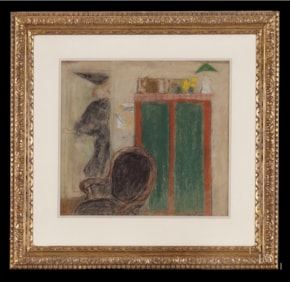Edouard Vuillard ( 1868 - 1940 )
Femme entrant dans le salon, c. 1896


Femme entrant dans le salon, c. 1896
stamped E.Vuillard lower right pastel on paper
13 ¾ x 15 ⅛ in. (35 x 38.5 cm)
Provenance:
Neffe-Degandt Gallery, London;
acquired from the above in 2007, thence by descent.
Exhibition:
London, JPL Fine Arts, Private View, May - July 1989, no. 39 (illustrated);
Glasgow, Art Gallery and Museum; Sheffield, Graves Art Gallery; Amsterdam, Van Gogh Museum, Vuillard, September 1991 - March 1992, no. 30, p. 45 and 94 (illustrated, p. 45).
Literature:
A. Salomon and G. Cogeval, Vuillard, The Inexhaustible Glance: critical catalogue of paintings and pastels. Paris, 2003, vol. I, p. 262 and 1699, no. IV-58 (illustrated, p. 262)
In 1890 Edouard Vuillard attended his first meeting of Les Nabis (The Prophets), a group of young artists in Paris who sought to reinvigorate the art of painting. Inspired by the example of Paul Gauguin, the Nabis consciously rejected academic traditions, intentionally painting in a non-naturalistic style, with bold flat areas of colour, emphasizing the two-dimensional and decorative qualities of their paintings. Though the group shared common ideas and ideals about art, there was a great variety of styles amongst the members, with artists such as Maurice Denis and Paul Sérusier using religious and mystical themes to imbue their paintings with an other-worldly, symbolist aura, whilst the likes of Pierre Bonnard, Félix Vallotton and Vuillard chose to paint subjects based on observations of the world around them.
For Vuillard, the interiors of his family home provided the setting for his most compelling works in the 1890s. He grew up surrounded by women. His mother was a corset maker with the family apartment doubling as her workshop, and constantly filled with seamstresses, as well as his sister and grandmother. He made many small scale pictures of women going about their daily tasks, five of which were exhibited at the third Exposition des peintres impressionnistes et symbolistes in 1892 where they were praised for their perceptiveness and subtlety, earning him the label intimiste. The pictures of this period, such as the two illustrated here, were modern in style but part of an older artistic tradition that stretched back to the paintings by Dutch seventeenth century masters, whose modest subjects and clear arrangement of forms appealed to Vuillard.
Although his subjects were done from life, Vuillard created from memory, a working practice that had been encouraged by Gauguin. This deliberate distancing from the motif combined with a stylization lifted from Japanese prints and other so called ‘primitive’ arts, resulted in uncompromisingly modern works. Unlike the paintings of his more symbolist contemporaries Vuillard’s intimiste pictures found an immediate audience. These two pastels from the early 1890s, reveal the influence of Japanese woodblock prints in their strong use of colour and silhouette.

